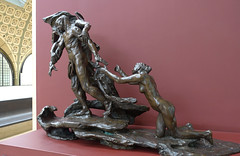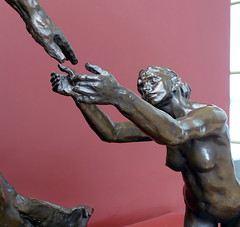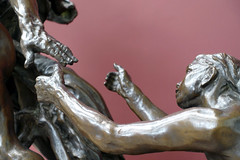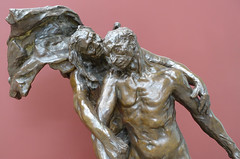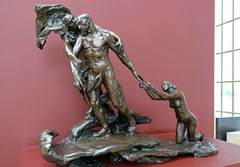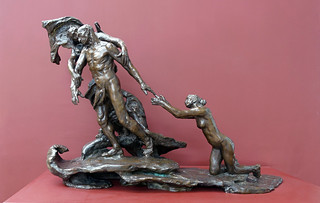8.9: Sculpture
- Page ID
- 75024
\( \newcommand{\vecs}[1]{\overset { \scriptstyle \rightharpoonup} {\mathbf{#1}} } \)
\( \newcommand{\vecd}[1]{\overset{-\!-\!\rightharpoonup}{\vphantom{a}\smash {#1}}} \)
\( \newcommand{\dsum}{\displaystyle\sum\limits} \)
\( \newcommand{\dint}{\displaystyle\int\limits} \)
\( \newcommand{\dlim}{\displaystyle\lim\limits} \)
\( \newcommand{\id}{\mathrm{id}}\) \( \newcommand{\Span}{\mathrm{span}}\)
( \newcommand{\kernel}{\mathrm{null}\,}\) \( \newcommand{\range}{\mathrm{range}\,}\)
\( \newcommand{\RealPart}{\mathrm{Re}}\) \( \newcommand{\ImaginaryPart}{\mathrm{Im}}\)
\( \newcommand{\Argument}{\mathrm{Arg}}\) \( \newcommand{\norm}[1]{\| #1 \|}\)
\( \newcommand{\inner}[2]{\langle #1, #2 \rangle}\)
\( \newcommand{\Span}{\mathrm{span}}\)
\( \newcommand{\id}{\mathrm{id}}\)
\( \newcommand{\Span}{\mathrm{span}}\)
\( \newcommand{\kernel}{\mathrm{null}\,}\)
\( \newcommand{\range}{\mathrm{range}\,}\)
\( \newcommand{\RealPart}{\mathrm{Re}}\)
\( \newcommand{\ImaginaryPart}{\mathrm{Im}}\)
\( \newcommand{\Argument}{\mathrm{Arg}}\)
\( \newcommand{\norm}[1]{\| #1 \|}\)
\( \newcommand{\inner}[2]{\langle #1, #2 \rangle}\)
\( \newcommand{\Span}{\mathrm{span}}\) \( \newcommand{\AA}{\unicode[.8,0]{x212B}}\)
\( \newcommand{\vectorA}[1]{\vec{#1}} % arrow\)
\( \newcommand{\vectorAt}[1]{\vec{\text{#1}}} % arrow\)
\( \newcommand{\vectorB}[1]{\overset { \scriptstyle \rightharpoonup} {\mathbf{#1}} } \)
\( \newcommand{\vectorC}[1]{\textbf{#1}} \)
\( \newcommand{\vectorD}[1]{\overrightarrow{#1}} \)
\( \newcommand{\vectorDt}[1]{\overrightarrow{\text{#1}}} \)
\( \newcommand{\vectE}[1]{\overset{-\!-\!\rightharpoonup}{\vphantom{a}\smash{\mathbf {#1}}}} \)
\( \newcommand{\vecs}[1]{\overset { \scriptstyle \rightharpoonup} {\mathbf{#1}} } \)
\( \newcommand{\vecd}[1]{\overset{-\!-\!\rightharpoonup}{\vphantom{a}\smash {#1}}} \)
\(\newcommand{\avec}{\mathbf a}\) \(\newcommand{\bvec}{\mathbf b}\) \(\newcommand{\cvec}{\mathbf c}\) \(\newcommand{\dvec}{\mathbf d}\) \(\newcommand{\dtil}{\widetilde{\mathbf d}}\) \(\newcommand{\evec}{\mathbf e}\) \(\newcommand{\fvec}{\mathbf f}\) \(\newcommand{\nvec}{\mathbf n}\) \(\newcommand{\pvec}{\mathbf p}\) \(\newcommand{\qvec}{\mathbf q}\) \(\newcommand{\svec}{\mathbf s}\) \(\newcommand{\tvec}{\mathbf t}\) \(\newcommand{\uvec}{\mathbf u}\) \(\newcommand{\vvec}{\mathbf v}\) \(\newcommand{\wvec}{\mathbf w}\) \(\newcommand{\xvec}{\mathbf x}\) \(\newcommand{\yvec}{\mathbf y}\) \(\newcommand{\zvec}{\mathbf z}\) \(\newcommand{\rvec}{\mathbf r}\) \(\newcommand{\mvec}{\mathbf m}\) \(\newcommand{\zerovec}{\mathbf 0}\) \(\newcommand{\onevec}{\mathbf 1}\) \(\newcommand{\real}{\mathbb R}\) \(\newcommand{\twovec}[2]{\left[\begin{array}{r}#1 \\ #2 \end{array}\right]}\) \(\newcommand{\ctwovec}[2]{\left[\begin{array}{c}#1 \\ #2 \end{array}\right]}\) \(\newcommand{\threevec}[3]{\left[\begin{array}{r}#1 \\ #2 \\ #3 \end{array}\right]}\) \(\newcommand{\cthreevec}[3]{\left[\begin{array}{c}#1 \\ #2 \\ #3 \end{array}\right]}\) \(\newcommand{\fourvec}[4]{\left[\begin{array}{r}#1 \\ #2 \\ #3 \\ #4 \end{array}\right]}\) \(\newcommand{\cfourvec}[4]{\left[\begin{array}{c}#1 \\ #2 \\ #3 \\ #4 \end{array}\right]}\) \(\newcommand{\fivevec}[5]{\left[\begin{array}{r}#1 \\ #2 \\ #3 \\ #4 \\ #5 \\ \end{array}\right]}\) \(\newcommand{\cfivevec}[5]{\left[\begin{array}{c}#1 \\ #2 \\ #3 \\ #4 \\ #5 \\ \end{array}\right]}\) \(\newcommand{\mattwo}[4]{\left[\begin{array}{rr}#1 \amp #2 \\ #3 \amp #4 \\ \end{array}\right]}\) \(\newcommand{\laspan}[1]{\text{Span}\{#1\}}\) \(\newcommand{\bcal}{\cal B}\) \(\newcommand{\ccal}{\cal C}\) \(\newcommand{\scal}{\cal S}\) \(\newcommand{\wcal}{\cal W}\) \(\newcommand{\ecal}{\cal E}\) \(\newcommand{\coords}[2]{\left\{#1\right\}_{#2}}\) \(\newcommand{\gray}[1]{\color{gray}{#1}}\) \(\newcommand{\lgray}[1]{\color{lightgray}{#1}}\) \(\newcommand{\rank}{\operatorname{rank}}\) \(\newcommand{\row}{\text{Row}}\) \(\newcommand{\col}{\text{Col}}\) \(\renewcommand{\row}{\text{Row}}\) \(\newcommand{\nul}{\text{Nul}}\) \(\newcommand{\var}{\text{Var}}\) \(\newcommand{\corr}{\text{corr}}\) \(\newcommand{\len}[1]{\left|#1\right|}\) \(\newcommand{\bbar}{\overline{\bvec}}\) \(\newcommand{\bhat}{\widehat{\bvec}}\) \(\newcommand{\bperp}{\bvec^\perp}\) \(\newcommand{\xhat}{\widehat{\xvec}}\) \(\newcommand{\vhat}{\widehat{\vvec}}\) \(\newcommand{\uhat}{\widehat{\uvec}}\) \(\newcommand{\what}{\widehat{\wvec}}\) \(\newcommand{\Sighat}{\widehat{\Sigma}}\) \(\newcommand{\lt}{<}\) \(\newcommand{\gt}{>}\) \(\newcommand{\amp}{&}\) \(\definecolor{fillinmathshade}{gray}{0.9}\)Sculpture
In the nineteenth century, sculptors rethought the representation of the body, finding new ways to express emotion.
c. 1865 - 1900
Jean-Baptiste Carpeaux, Dance
by DR. BETH HARRIS and DR. STEVEN ZUCKER
Video \(\PageIndex{1}\): Jean-Baptiste Carpeaux, Dance, 1865-69, marble, 420 x 298 cm. (Musée d’Orsay, Paris). Commissioned by Charles Garnier for the facade of L’Opéra. In 1964 it was replaced by a copy executed by Paul Belmondo.
Smarthistory images for teaching and learning:
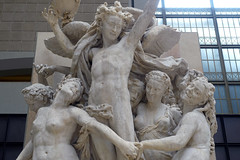
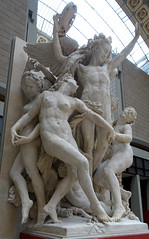

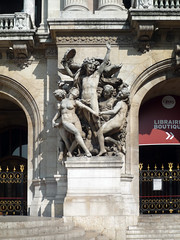
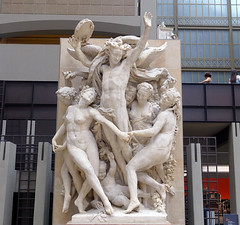
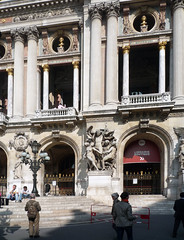
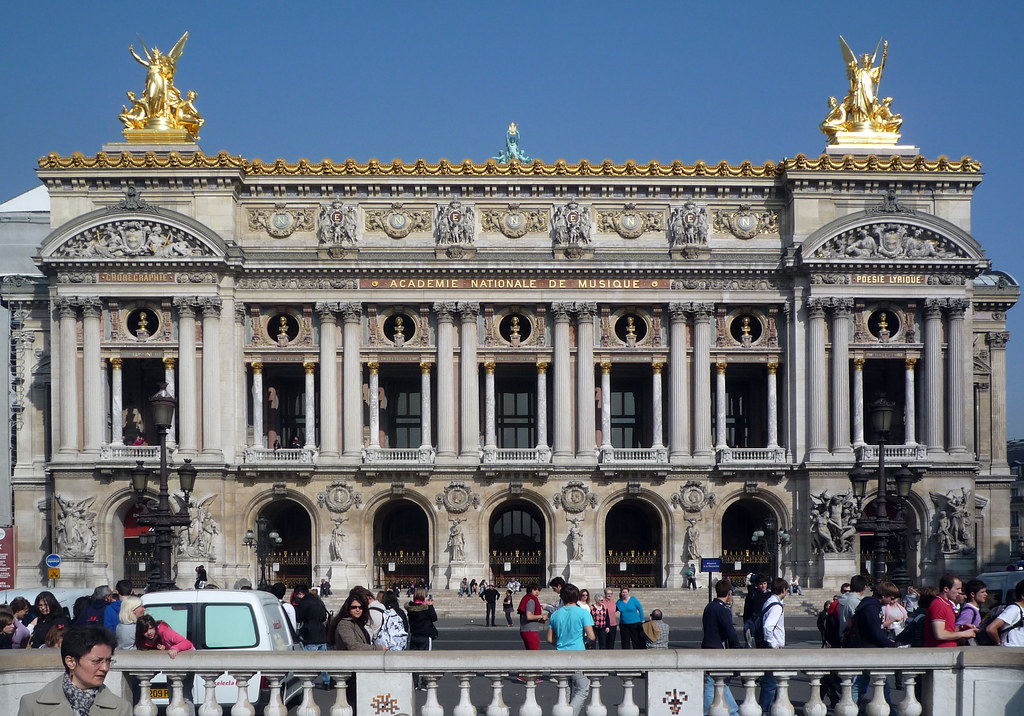
Auguste Rodin
Auguste Rodin, The Walking Man
by ELISABETH ROWNEY
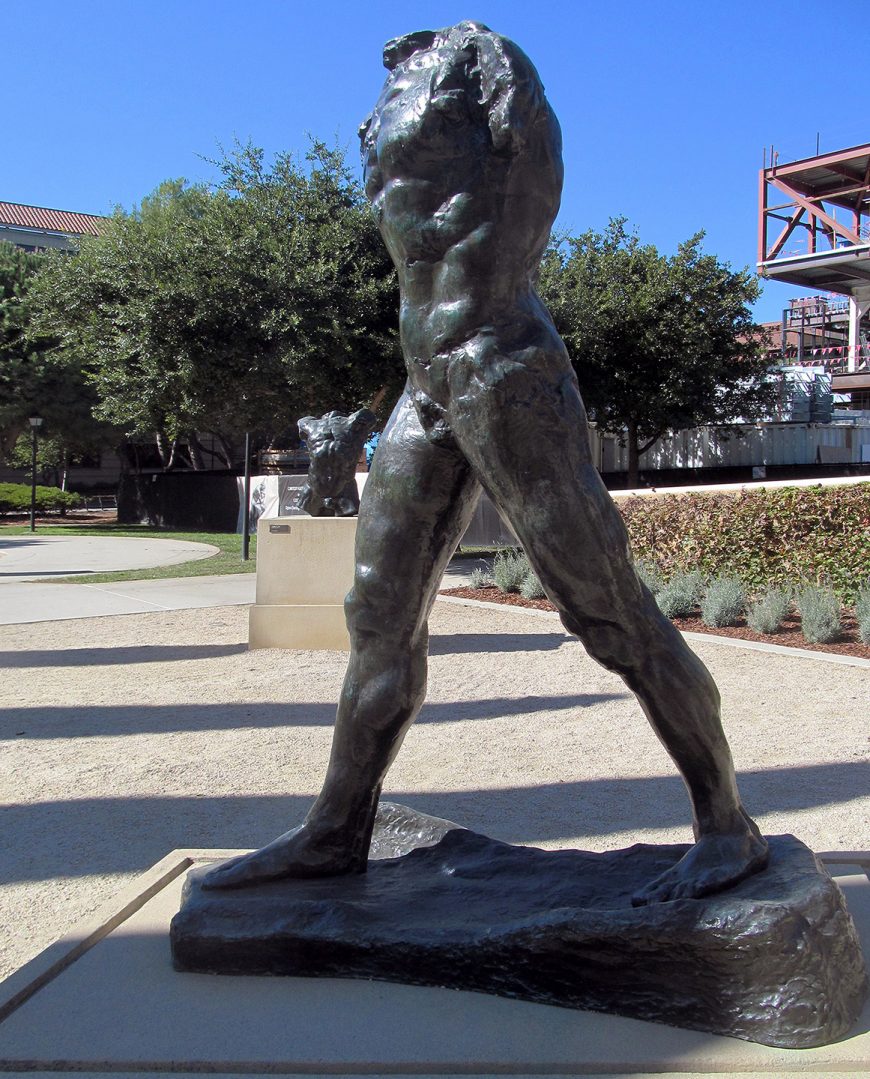
Who decides when a work of art is finished? An initial reaction may have you saying that the answer is the artist, but what happens when the artist’s painting or sculpture goes against preconceived notions of what constitutes a “completed” work of art? Auguste Rodin, a French artist who worked in the late 19th and early 20th centuries, was more interested in rough, blemished representations of the human body than idealized forms. He painstakingly immersed himself in his projects, sometimes spending years in order to develop a work of art, regardless of the public’s response. His sculpture was often judged harshly by the public and by critics (sculpture was in some ways a more conservative tradition than was painting).
Reuse
Like a painter who reworked an old canvas, Rodin had a penchant for reusing old molds and reworking his earlier ideas. While this was not uncommon among artists, Rodin would continue to alter an existing form until it developed a new identity and a new narrative. Rodin transformed a major work, a bronze sculpture—over the course of two decades—and titled it, The Walking Man.
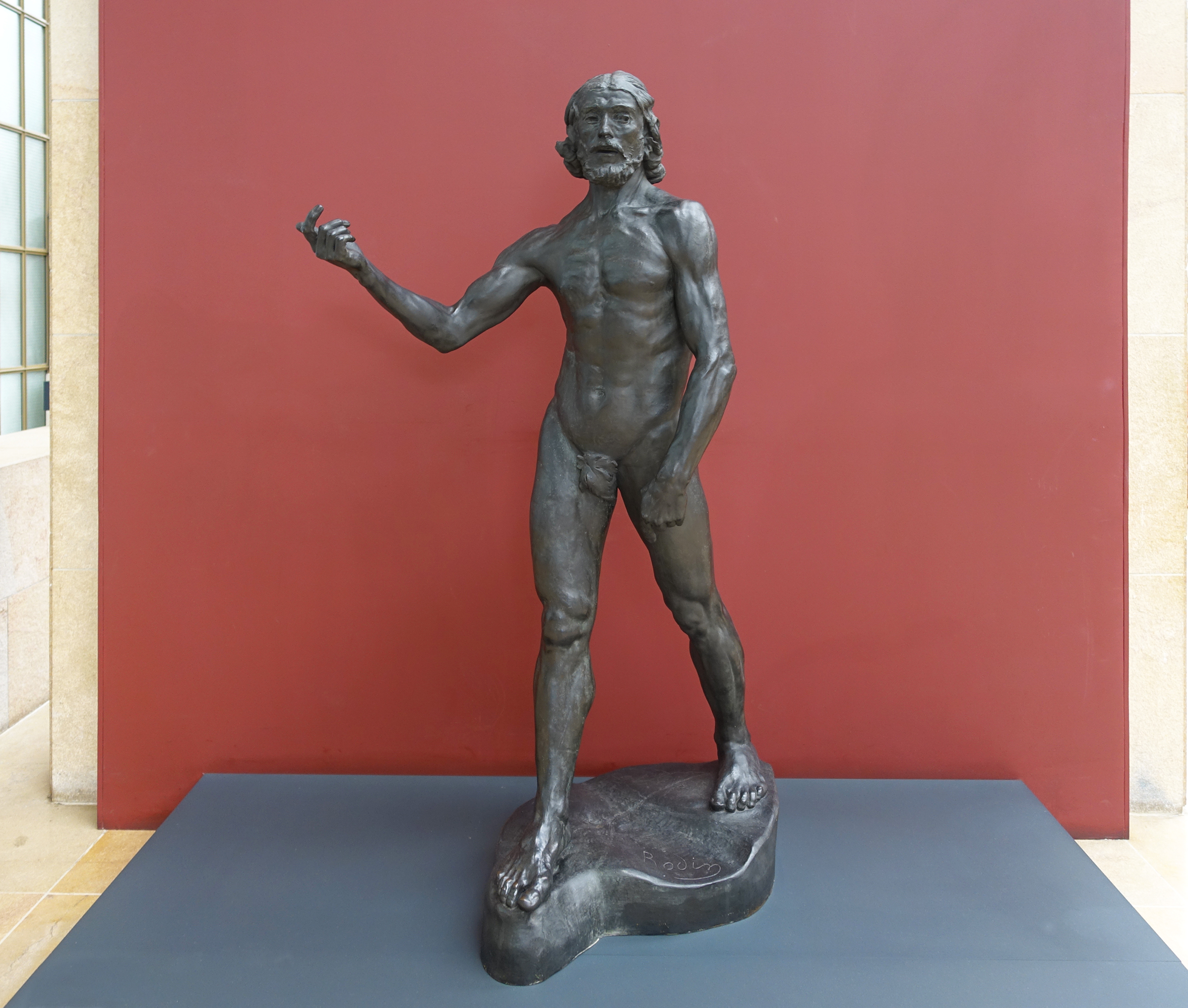
The Walking Man, started with his c. 1877 life-sized sculpture Saint John the Baptist Preaching (above), considered by many to be Rodin’s first life-sized masterpiece. The figure of Saint John is the embodiment of determination, with his head held high and his feet securely planted into the earthen bronze; his body balanced with the right arm extended as a counterweight to the contrapposto turn of his hips. Rodin was clearly interested in representing movement in this statue and continued to explore ways to perfect his “walking man.”

Power and movement
Rodin reused the widely-spread triangle-shaped stance from Saint John the Baptist Preaching and paired it with, what is thought to be, the torso mold from another earlier project. What resulted was a fragmented figure expressing power and movement. That Rodin was able to accomplish this without including a head and arms is remarkable and startling. The rough, fragmented body nevertheless achieves a solid stance and caused critics to complain that The Walking Man failed doubly; it could not possibly depict a man, and it was not walking.
This criticism missed the brilliant risk Rodin had taken. The male figure is posed in a wide stance, with the back foot turned to the side while the front weight-bearing foot is pointed straight ahead. The hips and torso are forward ready to take that much needed next step. The movement and motion is all right there in the arching torso, strong legs, and widely-spaced feet. Including additional appendages was unnecessary and would distract from the powerful combination of mass and movement.
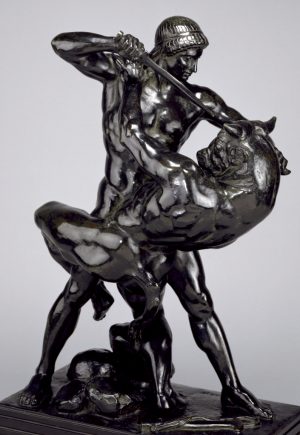
Rodin sculpted a jagged, textured surface instead of the traditionally smooth, unblemished skin that was preferred in the classically-inspired statues of that time (see the Barye sculpture, right). This uneven “skin” enhances the curvature of the calf and abdominal muscles as they tense and twist in preparation for the implied next stride.
The rough surface texture creates a continuous line of movement for the viewer’s eyes to follow. Motion is constant as light and shadow play across the surface. Unlike a sculpture with a smooth surface, light that reflects off of the uneven surfaces highlight its imperfections. Divots become darker and high crests become brighter. As the viewer moves around the statue, the light and dark areas change, appearing to undulate like the swells of the ocean.
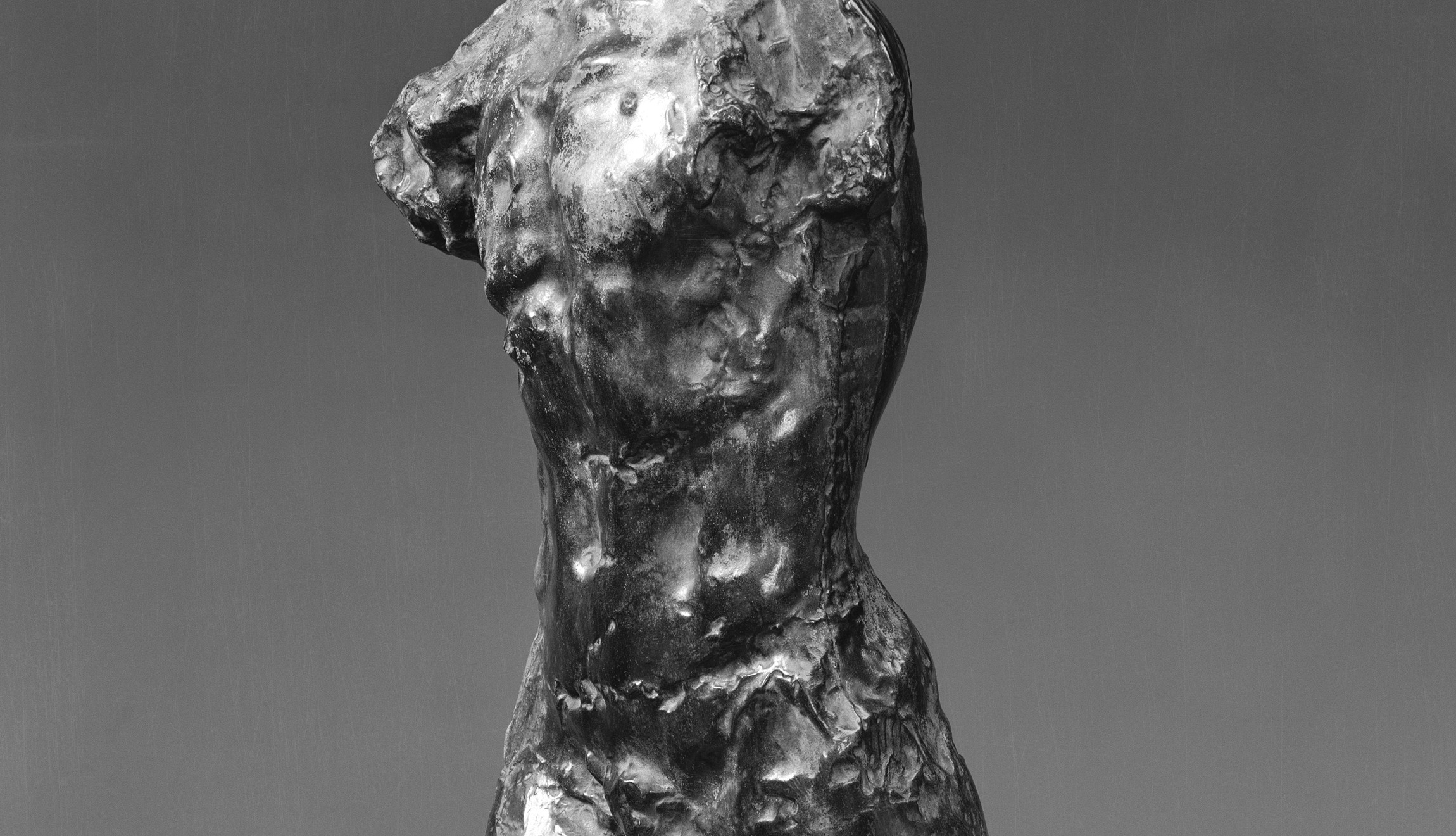
Rodin may not have created an overtly twisting and contorting figure, but the impression and implication of movement is very much present. He conveys motion and strength in a figure that is fragmented and seemingly unfinished. Does a statue need to include arms or a head in order for it to be declared complete? Do all limbs need to be present to depict movement? Rodin’s answer is no.
Auguste Rodin, The Burghers of Calais
by ELISABETH ROWNEY

Six men, one purpose
Have you ever been at a gathering surrounded by people and yet, felt completely and utterly alone? If you are familiar with those emotions – abandonment, loneliness, devastation— remember what it feels like and then take another look at the above sculpture by Auguste Rodin.
In 1885, Rodin was commissioned by the French city of Calais to create a sculpture that commemorated the heroism of Eustache de Saint-Pierre, a prominent citizen of Calais, during the dreadful Hundred Years’ War between England and France (begun in 1337).
We see six men covered only in simple layers of tattered sackcloth; their bodies appearing thin and malnourished with bones and joints clearly visible. Each man is a burgher, or city councilmen, of Calais, and each has their own stance and identifiable features. However, while they may stand together with a sense of familiarity, none of them are making eye contact with the men beside them. Some figures have their heads bowed or their faces obscured by raised hands, while others try to stand tall with their eyes gazing into the distance. They are drawn together not through physical or verbal contact, but by their slumped shoulders, bare feet, and an expression of utter anguish.

Rodin followed the recounting of Jean Froissart, a fourteenth-century French chronicler, who wrote of the war. According to Froissart, King Edward III made a deal with the citizens of Calais: if they wished to save their lives and their beloved city, then not only must they surrender the keys to the city, but six prominent members of the city council must volunteer to give up their lives. The leader of the group was Eustache de Saint-Pierre, who Rodin depicted with a bowed head and bearded face towards the middle of the gathering. To Saint-Pierre’s left, with his mouth closed in a tight line and carrying a giant set of keys, is Jean d’Aire. The remaining men are identified as Andrieu d’Andres, Jean de Fiennes, and Pierre and Jacques de Wissant.
Unbeknownst to the six burghers, at the time of their departure, their lives would eventually be spared. However, here Rodin made the decision to capture these men not when they were finally released, but in the moment that they gathered to leave the city to go to their deaths. Instead of depicting the elation of victory, the threat of death is very real. Furthermore, Rodin stretched his composition into a circle causing no one man to be the focal point which allows the sculpture to be viewed in-the-round from multiple perspectives with no clear leader.

The commission
Rodin spent most of his young life looking for approval and recognition. He was denied entry into the prestigious École des Beaux-Arts in Paris three times, and yet he continued to push forward until he could finally gain professional recognition. So, imagine his delight in 1885, when he was asked to create a monument for Calais. The only problem was he wanted to do it his own way.

It was common in the nineteenth-century to depict an event with a single heroic figure. For example, Rodin’s later sculpture Monument to Balzac (1891-97), where the French playwright and novelist, Honoré de Balzac, is shown standing tall and alone with his head held high. This is similar to what the city of Calais was inevitably expecting from Rodin. As a result, they were displeased with Rodin’s concept—they wanted only one statue; the one of Eustache de Saint-Pierre. Instead, Rodin included all six men from Froissart’s account.
A closer look
While these six men, at first glance, may look fragile, the heavy, rhythmic drapery that hangs from their shoulders falls to the ground like lead weights, anchoring them and creating a mass of strong, unyielding bodies.

In fact, the fabric appears to almost fused to the ground—conveying the conflict between the men’s desire to live and the need to save their city. Rodin included raised portions of the floor under the men’s feet which would have, ultimately, made some of the men appear higher than others, yet they are all sculpted to be around the same height, that of an adult male. The burghers were not meant to be viewed in the form of a hierarchal pyramid with Eustache de Saint-Pierre at the top, which would have been typical in a multi-figure statue, but as a group equal in status. By bringing these men down to ‘street level,’ Rodin allowed the viewer to easily look up into the men’s faces mere inches from his/her own; enhancing the personal connection between the viewer and the six men.
The outcome
Because the patrons wanted a heroic quality, with a raised pedestal that would place the figures in a God-like status high above the viewers, Rodin presented the city of Calais with The Burghers of Calais complete with a pedestal. However, the raised pedestal did not allow an audience to view the work of art as Rodin had intended. Therefore, he created a second version, one lacking a pedestal, to be placed at the Musée Rodin at the Hôtel Biron in Paris. Rodin’s goal was to bring the audience into his sculpture of The Burghers of Calais, and he accomplished this by not only positioning each figure in a different stance with the men’s heads facing separate directions, but he lowered them down to street level so a viewer could easily walk around the sculpture and see each man and each facial expression and feel as if they were a part of the group, personally experiencing the tragic event.

Throughout his career, Rodin took risks and created his works of art in his own, albeit unconventional, way. As a result, Rodin set a standard for artists who came after him and his Burghers of Calais became one of his most well-known and studied works.
Additional resources:
Chronology of Rodin’s life from the Musée Rodin
The Burghers of Calais on The Metropolitan Museum of Art’s Timeline of Art History
Smarthistory images for teaching and learning:
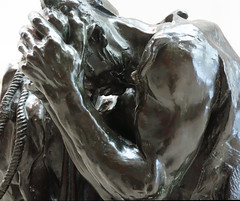
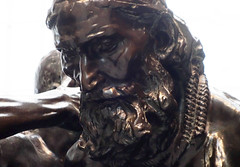
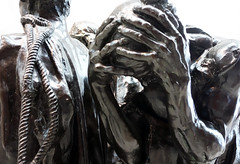
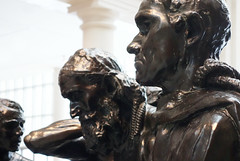

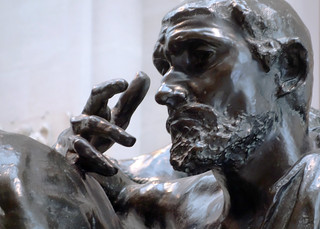
Auguste Rodin, The Gates of Hell
by DR. BETH HARRIS and DR. STEVEN ZUCKER
Video \(\PageIndex{2}\): Auguste Rodin, The Gates of Hell, 1880-1917, plaster (Musée d’Orsay, Paris)
When the building that stood on what is now the site of the Musée d’Orsay in Paris was destroyed by fire during the Commune in 1871, plans were drawn up to replace it with a museum of decorative arts. Rodin won the competition to design a great set of doors for its entryway. Although the museum was never built, Rodin continued to work on the doors. They became an ongoing project; a grand stage for his sculptural ideas. It’s fitting that the plaster of this great unfinished sculpture, The Gates of Hell, is now on display at the d’Orsay, the former railway terminal that was built on this site instead of the museum of decorative arts and that, by lovely coincidence, was converted into one of the world’s great art museums.
Smarthistory images for teaching and learning:
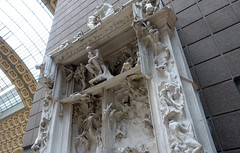
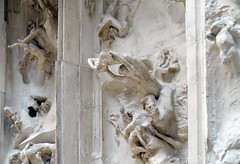
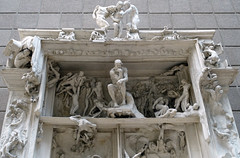
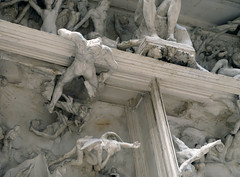
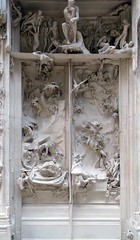
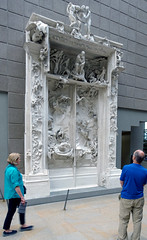
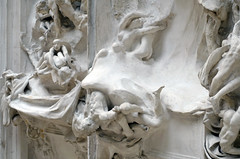
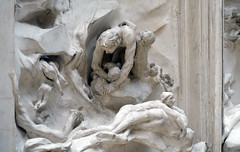

Camille Claudel, The Age of Maturity
by BEN POLLITT

Her masterpiece
Towards the end of the nineteenth century, we find an increasing number of women taking their place among the most progressive artists of their age. It would be hard though to find one whose works are so radical in style and execution as Camille Claudel. The breadth and seriousness of her achievement have left a lasting legacy, one that particularly in recent years has secured Claudel’s reputation as one of the eminent sculptors of her age. Rather than Rodin’s lover/muse, who also happened to sculpt, Claudel is now universally acknowledged as a great sculptor in her own right.
Her masterpiece, The Age of Maturity, was exhibited in plaster in 1899, before being cast in bronze in 1902. The original work, commissioned by the French state in 1895, is believed to have been destroyed by the artist after the second casting in 1913.
The subject presents us with three naked figures, a young woman on her knees whose outstretched hands appear to have just released from their grip the hand of an older man, who is held in the arms of another, older woman, who appears to be compelling the man forward and away from the young woman. The title points to an allegory of aging, in which the man, the protagonist of the piece, is leaving his youth and moving towards old age and death.

Claudel’s first version of the work, made in plaster in 1894-5, depicts a kneeling figure who connects physically with the man. The male figure seems passive, to the point of near collapse, his right arm hanging limply over the shoulders of the old woman, who leans in, glaring at the kneeling figure, evidently conscious of her as a rival. This interaction between the figures representing youth and old age is later rejected in favor of the more arresting dynamic in which the figures lurch forward in the same direction, as though compelled by the inescapable force of time.
In the final version, the futility of youth to halt its progress toward old age is captured sharply in the small but significant gap that isolates her from the other figures and in her relatively low level. Unlike the first version, in which the figures stand naked on a flat plinth, the final version makes expressive use of organic forms, notably the billowing drapery that unites the man and older woman and the three levels of rock which end in a wave-like curve, reminding us not only of the influence of Art Nouveau aesthetics on Claudel’s work in the late 1890’s, but also perhaps of the theatricality of Baroque sculpture.
The Vanished God

A year after the first version was exhibited, Claudel reworked the female figure in a piece entitled The Vanished God; a work remarkable for its expressive qualities; its head of matted locks, coiling ropelike around the smooth and rounded forms of the body; the face an image of anguish, the lips parted slightly, the eyebrows raised, the intensity of the gaze leveled toward the space between the cupped hands. The void itself is highly suggestive, raising the question, what is this god that has vanished? Is it a lover, perhaps, to whom her head tilts to kiss? (Claudel and Rodin had ended their relationship shortly before the work was made.) Is it love itself? Or faith? Is it, as some commentators maintain, a baby? This last, much disputed reading, citing the slight sag in the belly, links the anguish of the figure to Claudel’s own sense of despair having—it is said—terminated a pregnancy in 1892, the child being Rodin’s. The evidence for this though is scant. For the artist’s brother, the Catholic poet Paul Claudel, who certainly read the work autobiographically, what has vanished is something wholly intangible: “…my sister Camille, imploring, humiliated, on her knees, that superb, proud creature, …what is being wrenched from her, right there before your very eyes, is her soul.”
Clotho

Precedence for the other female figure can be found in works such as Clotho.
As in Rodin’s poignant depiction of old age, She Who Was the Helmet Maker’s Once-Beautiful Wife, Claudel unflinchingly presents the impact of time on the human body in Clotho. There are notable differences, though. Whereas Rodin’s once-beautiful wife looks down seemingly ashamed of her aged body, Clotho’s haunting figure strides actively forward.

Like The Vanished God, she too sports a head of matted hair, though thicker and gnarlier, like the roots or branches of an old tree, reminding us perhaps of the Roman poet Ovid, whose Metamorphoses describes the mythological transformation of humans into natural phenomena, such as flowers, trees and constellations, a process in which the individual at the point of death is subsumed into the organic whole of the universe. Here, of course, that masterpiece of Baroque sculpture, Bernini’s Apollo and Daphne, the most famous sculptural interpretation of Ovid, might also come to mind.
The mythological reading
The connection is more than merely visual, but reveals something of the mythological intent not only of Clotho, but of The Age of Maturity itself. Clotho, after all, is a figure from Greco-Roman mythology, the youngest of the three sister Fates, who decided human destiny. Indeed, an alternative title to The Age of Maturity is Destiny, a theme, central to Ovid’s narrative, that Claudel was clear to identify in a letter to Paul, written while working on her first version of this major work, stating that she intended to include in it a tree. Aside from Greco-Roman mythology, the tree motif is linked with destiny in many other cultural belief systems, the cross on which Christ was crucified, the Bodhi tree under which Buddha achieved enlightenment, the world tree Yggdrasil in old Norse that Odin sacrificed himself upon, a story illustrated by Danish artist, Lorenz Frolich.

Deciding against such a literal representation, however, in the final version of The Age of Maturity Claudel opts instead for the biomorphic form of that huge, twisting drapery, which when seen from the rear, takes on a distinctly arboreal character.
The love triangle reading
That the work is a symbolic representation of destiny was certainly the prevailing view of contemporary critics. In later times, however, informed by the tragic circumstances of Claudel’s life, The Age of Maturity has been read in more autobiographical terms, telling the tale of Claudel’s turbulent relationship with Rodin, a man twenty-four years her senior.
Claudel joined Rodin’s studio in 1884, assisting him in the completion of some of his most important works, including The Gates of Hell. The two became lovers, until in 1893 Rodin made the decision to leave Paris to settle in Meudon with his long-term mistress and the mother of his son, Rose Beuret, an episode most commonly cited as the inspiration for The Age of Maturity. With this in mind, rather than the inevitable passage of time, the theme of the work shifts somewhat to one of choice and how one’s choices come to define us. Claudel’s own feelings about Rodin’s decision seem clear enough. The almost diabolical Clotho figure is hardly flattering as a portrait of Rose, while the way the man’s groin is covered by drapery suggests a decision made less for the sake of modesty than to suggest the fact that Rodin’s rejection of passionate love in favor of security and domestic equilibrium has effectively emasculated him.
Fortunately, like all great works of art, The Age of Maturity withstands these alternative readings. Rather than cancelling each other out, instead they intersect and nurture more possible approaches to understanding what must stand as a key moment in the career of a female artist no longer confined in her choice of medium or of subject matter.
Additional resources:
Claudel and Rodin from the Musée Rodin
Rodin on The Metropolitan Museum of Art’s Heilbrunn Timeline of Art History
Smarthistory images for teaching and learning:
